Podcast: Play in new window | Download
Subscribe: RSS
Nobody ever talks about catatonia in autism. This podcast explores the symptoms of catatonia, how to measure it, what parents should know about tracking the symptoms, what the treatments are, and what the causes are. Dr. Martine Lamy from Cincinnati Children’s Hospital explains her work looking at genetic causes in those with catatonia and neurodevelopmental disorders. It’s important to do genetic testing on all individuals who present with catatonia because this information led to better treatments in some people. Identifying a genetic cause of not just catatonia but also neurodevelopmental disorders like ASD gives families a community but also allows them to identify more targeted interventions.
https://pubmed.ncbi.nlm.nih.gov/37864080/
https://pubmed.ncbi.nlm.nih.gov/37642312/

